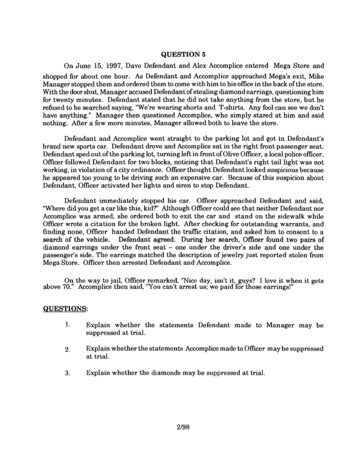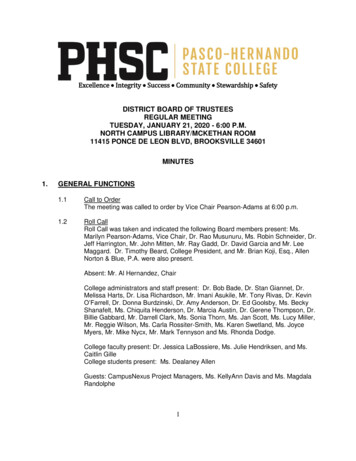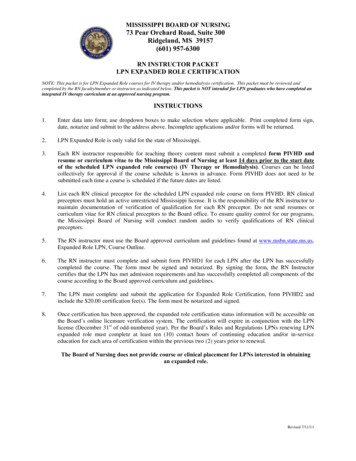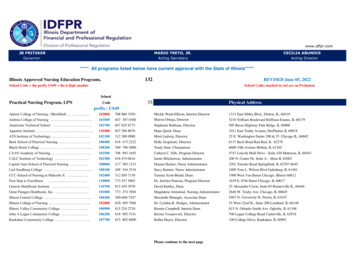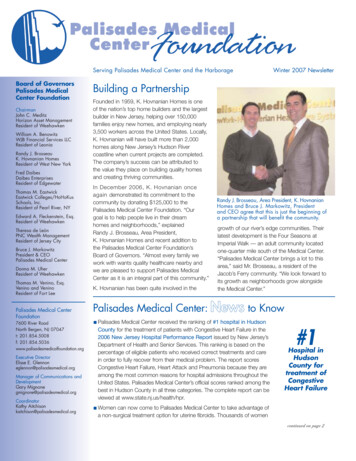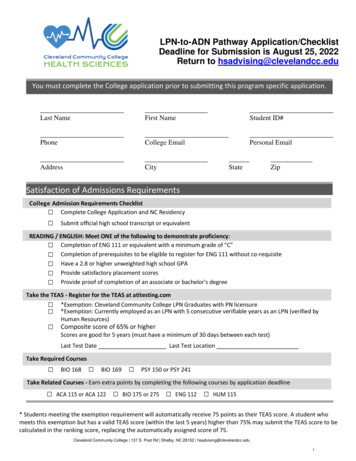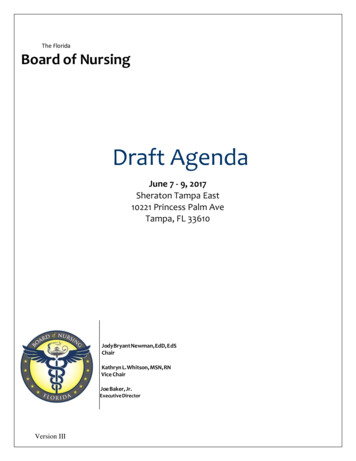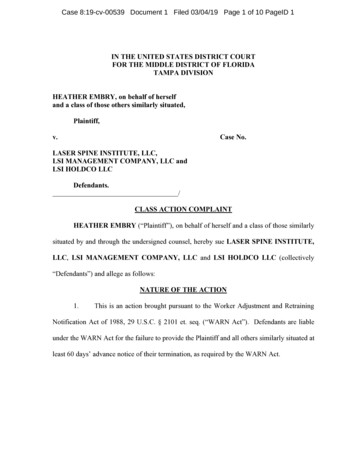
Transcription
Lopes v. Riendeau et alDoc. 157 Att. 1Case 1:14-cv-10679-NMG Document 155 Filed 07/27/16 Page 1 of 7UNITED STATES DISTRICT COURT FORTHE DISTRICT OF MASSACHUSETTSDANA E. LOPES,)Plaintiff,))v.)CIVIL ACTION NO. 1:14-cv-10679-NMG)MPCH, et. al.,)Defendants.)DEFENDANT BARBARA BERG, LPN’SCONCISE STATEMENT OF MATERIAL FACTSPursuant to Local Rule 56.1, Defendant Barbara Berg (“Defendant”) offers the followingstatement of material facts in support of her Motion for Summary Judgment:1.Pursuant to Fed. R. Civ. P. 10(c), Defendant Berg hereby adopts and incorporates byreference Defendants, Dyana Nickl and Geraldine Riendeau, Statement of UndisputedFacts in Support of their Motion for Summary Judgment (Doc. 100) in its entirety, as ifeach numbered paragraph was restated here.2.Pursuant to Fed. R. Civ. P. 10(c), Defendant Berg hereby adopts and incorporates byreference Defendants Paul Caratazzola, Patricia Davenport-Mello, and MassachusettsPartnership for Correctional Healthcare’s Concise Statement of Material Facts (Doc.139) in its entirety, as if each numbered paragraph was restated here.3.Pursuant to Fed. R. Civ. P. 10(c), Defendant Berg hereby adopts and incorporates byreference Defendants, Dyana Nickl and Geraldine Riendeau, Statement of UndisputedFacts in Support of their Renewed Motion for Summary Judgment (Doc. 149) in itsentirety, as if each numbered paragraph was restated here.Plaintiff4.Plaintiff Dana Lopes (“Plaintiff”) is inmate presently incarcerated with theMassachusetts Department of Correction (“DOC”) at MCI-Shirley. (Doc. 139, ¶1). Atthe time of the filing of his Complaint, Plaintiff was incarcerated by the DOC at OldColony Correctional Center (“OCCC”) in Bridgewater, MA. (Doc. 139, ¶1).5.Plaintiff has a history of Hepatitis C, dating back more than 35 years, and also suffersfrom cirrhosis of the liver and end-stage liver disease. (Doc. 100, ¶13; Doc. 120, pgs.2425).Dockets.Justia.com
Case 1:14-cv-10679-NMG Document 155 Filed 07/27/16 Page 2 of 7UMCH Co-Defendants6.Defendant University of Massachusetts Correctional Health (“UMCH”) provided medicalservices to DOC inmates, incarcerated at OCCC, from 2003 to June 30, 2013. (ExhibitA, Affidavit of Barbara Berg, LPN, ¶¶4-9; Doc. 27-1, ¶4). In 2003, the DOC hadcontracted the University of Massachusetts Medical School (“UMMS”), a publiclyowned university, to become the new medical provider at DOC operated facilities. (Exh.A, ¶4; Doc. 27-1, ¶¶2-9). UMMS provided medical services to DOC inmates throughUMCH, which was a department within the UMMS. (Exh. A, ¶¶4-5; Doc. 27-1, ¶¶3-4).7.Defendant Geraldine Riendeau, RN was formerly the Health Service Administrator(“HSA”) at OCCC, and worked for UMCH at all times relevant to the Complaint. (Doc.149, ¶2). Defendant Riendeau was a public employee, subject to the direction andcontrol of UMCH. (See Doc. 149, ¶¶13-20).8.Defendant Dyana Nickl was UMCH’s Senior Director of Operations, and served asUMCH’s Grievance and Appeals Coordinator at all relevant times to Plaintiff’sComplaint. (Doc. 149, ¶¶3,21). Defendant Nickl was a public employee, subject to thedirection and control of UMCH. (See Doc. 149, ¶¶21-25).MPCH Co-Defendants9.Defendant Massachusetts Partnership for Correctional Healthcare, LLC (“MPCH”) is aprivately owned company, affiliated with MHM Services, Inc. (“MHM”), which has beenthe contracted medical provider for the DOC since July 1, 2013. (Exh. A, ¶¶7-9; Doc.139, ¶¶2-6).10.On July 1, 2013, Defendant Paul Caratazzola, LICSW was hired by MPCH to become theHSA at OCCC, and worked for MPCH/MHM at all times relevant to the Complaint.(Doc. 139, ¶¶5-7, 11). Defendant Caratazzola was a private employee, subject to thedirection and control of MPCH. (Doc. 139, ¶¶5-7, 11).11.On July 1, 2013, Defendant Patricia Davenport-Mello, RN was hired by MPCH tobecome the Director of Nursing at OCCC, and worked for MPCH/MHM at all timesrelevant to the Complaint. (Doc. 139, ¶¶9-11).Defendant Barbara Berg, LPN12.In 2003, Defendant Barbara Berg, LPN was hired by UMCH as a LPN at OCCC. (Exh.A, ¶6).13.While employed by UMCH, Defendant Berg reported to and was directly supervised byUMCH’s HSA and Director of Nursing. (Exh. A, ¶¶12, 16). Additionally, UMCHmanagement staff set her hours, determined what unit she worked on during any givenshift, and determined which patients she would treat. (Exh. A, ¶13).2
Case 1:14-cv-10679-NMG Document 155 Filed 07/27/16 Page 3 of 714.During her employment with UMCH, Defendant Berg’s salary was paid by UMMS andwas not dependent on the number of inmates she treated. (Exh. A, ¶13). As an employeeof UMCH, a publicly owned entity, Defendant Berg was able to participate in benefitsprograms only offered to Commonwealth of Massachusetts’ employees, such as thestate’s retirement program. (Exh. A, ¶¶4, 14).15.As an employee of UMCH, Defendant Berg was bound by the policies and proceduresUMCH had developed concerning the care provided to patients at OCCC. (Exh. A, ¶15).During her employment with UMCH, the care and treatment Defendant Berg provided tothe Plaintiff was done so in accordance with these policies and procedures. (Exh. A, ¶15).16.On July 1, 2013, Defendant Berg became an employee of MPCH when MPCH becamethe contracted medical provider at OCCC. (Exh. A, ¶¶7, 9; Doc. 139, ¶12). At this time,Defendant Berg continued her job as a LPN at OCCC. (Exh. A, ¶¶7, 9).17.Since becoming an employee of MPCH on July 1, 2013, Defendant Berg’s salary hasbeen paid by MHM, and is still not dependent upon the number of inmates she treats.(Exh. A, ¶¶9, 17). As MHM is privately owned, Defendant Berg is no longer able toparticipate in the Massachusetts state retirement program nor any other benefit programsonly offered to state employees. (Exh. A, ¶¶8,17).18.During her employment with MPCH as a LPN at OCCC, Defendant Berg was directlysupervised by MPCH’s Director of Nursing at OCCC. (Exh. A, ¶18). Additionally,MPCH management staff set her hours, determined what unit she would work on duringany given shift, and determined which patients she would treat. (Exh. A, ¶18).19.As an employee of MPCH, Defendant Berg was bound by the policies and proceduresMPCH had developed concerning the care provided to patients at OCCC. (Exh. A, ¶19).During her employment with MPCH, the care and treatment Defendant Berg provided tothe Plaintiff was done so in accordance with these policies and procedures. (Exh. A, ¶19).20.During her employment as an LPN at OCCC, with both UMCH and MPCH, DefendantBerg worked as a medication nurse. (Exh. A, ¶11). In this role, she was responsible foradministering medication to multiple patients, takin off provider orders, conducting KOPaudits, proofreading Medication Administration Records, maintaining medications or allpatients, providing patient treatments, and conducting other various duties as assigned.(Exh. A, ¶11). Defendant Berg was not responsible for prescribing medications,diagnosing illnesses, or ordering specific medical treatment. (Exh. A, ¶11).21.Defendant Berg has never been employed by the DOC, nor has she ever been supervisedby or collected a salary from the DOC. (Exh. A, ¶21).3
Case 1:14-cv-10679-NMG Document 155 Filed 07/27/16 Page 4 of 7Medical Treatment Provided by UMCH22.From November 2003 to May 2004, UMCH medical staff treated Plaintiff’s Hepatitis Cwith “Peg-Intron” and “Ribavirin.” (Doc. 100, ¶33; Doc. 120, pg.25). However, this drugregiment ended because Plaintiff developed anemia and vision changes with cotton woolspots seen on his eye exam. (Doc. 100, ¶33; Doc. 120, pg.25). Plaintiff was furtherunable to restart treatment with these medications because of issues with ascites. (Doc.100, ¶33).23.In August 2005 and April 2006, Plaintiff was treated at Tufts-New England MedicalCenter (“Tufts”). (Doc. 120, pg.25). The Tufts physician noted that Plaintiff was not acandidate for a liver transplant. (Doc. 120, pgs.25-26). Specifically, the physician notedthat Plaintiff’s “risk of dying from the liver transplant would be higher than the risk ofdying from his liver disease.” (Doc. 120, pg.26).24.In 2006, following Plaintiff’s evaluation at Tufts, Philip Tavares, MD (“Dr. Tavares”) ofUMCH examined Plaintiff and assessed his end-stage liver disease as stable. (Doc. 120,pg.26). Dr. Tavares’ adopted Tufts findings that Plaintiff should be put on a weight lossprogram and discontinued from narcotics, so that the risks associated with a livertransplant could potentially be reduced. (Doc. 120, pg.26).25.In another 2006 visit, Dr. Tavares planned to check the date of Plaintiff’s last liverultrasound and order another ultrasound or CT scan “as indicated.” (Doc. 120, pg.26).26.Throughout 2006, Plaintiff was seen several additional times by UMCH in the prisoninfirmary, and his condition was described as stable. (Doc. 120, pg.26).27.From 2008 to 2012, UMCH staff continuously monitored Plaintiff’s liver disease withCT scans and outside medical consults. (Doc. 100, ¶¶33-50; Doc. 120, pgs. 28-29).28.In 2011, the Food and Drug Administration (“FDA”) approved two new medications totreat Hepatitis C, namely, “Boceprevir” and “Telaprevir.” (Doc. 120, pg.27). However,both of these medications required that they be taken in combination with peginterferonalfa ribavirin. (Doc. 120, pgs.27-28).29.In March 2012, the Plaintiff was evaluated by Richard J. Rohrer, M.D. (“Dr. Rohrer) atTufts, who again concluded that Plaintiff could not tolerate interferon therapy. (Doc. 120,pg.28). Dr. Rohrer further stated that Plaintiff did not qualify for a liver transplantbecause the lesion on his liver was too small, but recommended that UMCH continue toobserve it. (Doc. 120, pg.29).30.On April 24, 2012, Plaintiff was evaluated by Angela S. Dantonio, N.P. (“Dantonio”) atUMass Memorial Medical Center in Worcester, MA (Doc. 120, pg.29). Dantonioconcluded that a four-phase CT scan was needed to determine if Plaintiff couldpotentially be a liver transplant candidate. (Doc. 120, pg.29).4
Case 1:14-cv-10679-NMG Document 155 Filed 07/27/16 Page 5 of 731.Per Dantonio’s recommendation, UMCH staff performed a four-phase CT scan ofPlaintiff’s pelvis and abdomen and returned him to UMass Memorial Medical Center tobe re-evaluated by multiple-providers for his chronic hepatitis C, cirrhosis and liver masson May 17, 2012 (Doc. 120, pg.30).32.On May 17, 2012, three radiologists at UMass Memorial Medical Center reviewedPlaintiff’s four-phase CT scan and decided that an MRI needed to be obtained beforeconsidering a liver biopsy. (Doc. 120, pg.31). In June 2012, Plaintiff agreed to undergothis MRI. (Doc. 120, pg.31).33.In August 2012, Plaintiff had the MRI. (Doc. 120, pg.32). In November 2012, heunderwent a fine needle aspiration biopsy and a radio frequency ablation of the lesion onhis liver. (Doc. 120, pg.32). In December 2012, Plaintiff had a three-phase CT scan ofhis abdomen and pelvis. (Doc. 120, pg.32).34.On January 31, 2013, Plaintiff was seen again at UMass Memorial Medical Center, wherethe multidisciplinary team decided to continue surveillance of Plaintiff’s condition withimaging three months after the December 2012 CT scan. (Doc. 120, pgs.32-33).35.On or about February 2013, Plaintiff was found to be non-compliant with his Keep onPerson (“KOP”) medication, and UMCH staff began requiring Plaintiff to retrieve hisdaily medication from the Medication line to prevent overdosing. (Doc. 101-5, pgs.2-11).36.In March 2013, Plaintiff was admitted to Lemuel Shattuck Hospital (“LSH”) for a “selfinduced low nutritional intake.” (Doc. 120, pg.33). Medical staff at LSH recommendedcontinued management on an outpatient basis of Plaintiff’s liver disease and continueddosing of diuretic medication. (Doc. 120, pg.34).37.In July 2013, MPCH began providing medical services to OCCC inmates, including thePlaintiff, which were previously provided by UMCH. (Doc. 120, pg.34).Medical Treatment Provided by MPCH38.When MPCH began providing care to Plaintiff, in July 2013, Mr. Lopes was sufferingfrom Chronic Hepatitis C with cirrhosis. (Doc. 139, ¶13).39.In an April 14, 2014 letter, the Director of Clinical Services of DOC Health ServicesDivision advised the Plaintiff that MPCH did not “have an alternative treatment plan thatdoes not include the Peg Intron at this time” and MPCH was “working on obtainingnewer treatments.” (Doc. 120, pg.34). The letter also explained to the Plaintiff that hisprior development of “cotton wool spots” caused by the “Peg Intron treatment” couldresult in blindness if such treatment was given per Plaintiff’s request. (Doc. 120, pg.34).40.Plaintiff has a specific viral mutation, which predicts resistance to protease inhibitors(“PI”) Boceprevir and Telaprevir. (Doc. 139, ¶14). On July 23, 2014, Mr. Lopesunderwent testing at Boston Medical Center, where an attending physician in the5
Case 1:14-cv-10679-NMG Document 155 Filed 07/27/16 Page 6 of 7Gastroenterology Department repeated the ongoing recommendation that Mr. Lopesavoid PIs in regards to treatment of his Hepatitis C Virus (“HCV”). (Doc. 139, ¶14).41.Since MPCH began caring for the Plaintiff on July 1, 2013, Plaintiff’s condition has beenmonitored with multiple lab tests, diagnostic procedures, and chronic diseaseconsultations with medical professionals outside of MPCH, while MPCH medical staffwaited for the U.S. Food and Drug Administration (“FDA”) to approve a new form oftreatment. (Doc. 139, ¶15).42.An August 20, 2014 letter to the Plaintiff from the Assistant Deputy Commissioner of theDOC Health Services Division reiterated to the Plaintiff that “Boceprevir and Telaprevirmedication have to be given with the Peg Interferon” and Plaintiff could not have thembecause of his prior negative side effects to Peg Interferon. (Doc. 120, pg.34).43.In October of 2014, the FDA approved the use of Harvoni to treat HCV. (Doc. 139, ¶16).Harvoni provided the first FDA approved interferon-free and ribavirin-free regimen totreat Hepatitis C. (Doc. 120, pg.35).44.On January 21, 2015, Plaintiff was seen at the Lemuel Shattuck Hospital’s (“LSH”) GIClinic, for new treatment options, where it was recommended that Plaintiff be started ona twelve week trial of Harvoni. (Doc. 139, ¶17).45.Per the recommendation of the LSH GI Clinic, MPCH medical staff approved Plaintiff tobegin treatment with Harvoni. (Doc. 139, ¶18). As a result, Plaintiff was placed on atwelve week trial of Harvoni, which began on March 2, 2015 and ended on May 24,2015. (Doc. 139, ¶18).46.The Harvoni treatment was successful, as subsequent lab tests confirmed that the HCVwas no longer present in Plaintiff’s blood. (Doc. 139, ¶19).47.Since Plaintiff’s successful Harvoni treatment, MPCH staff have continued to monitorPlaintiff for any signs of the HCV returning. (Doc. 139, ¶20). MPCH has also continuedto provide the Plaintiff with care for additional medical conditions unrelated to the HCV.(Doc. 139, ¶20).48.On May 4, 2016, Plaintiff informed MPCH that he was refusing to undergo any furthergastrointestinal evaluations and follow-up appointments for liver disease. (Doc. 139,¶21). On this same date, Plaintiff signed a Release of Responsibility form acknowledgingthat he understood the risks associated with refusing such treatment. (Doc. 139, ¶21).49.Plaintiff’s present Primary Care Clinician, Maria Angeles, MD, will continue to offer andprovide Plaintiff with appropriate medical treatment and monitoring for liver disease, ifand when Plaintiff permits MPCH medical staff to do so. (Doc. 139, ¶22).6
Case 1:14-cv-10679-NMG Document 155 Filed 07/27/16 Page 7 of 7Grievances50.While UMCH was the contracted medical provider at OCCC, inmates were required tofollow UMCH’s grievance process if they had a complaint about the medical care theywere receiving. (Doc. 101, pg.14; Doc. 101-5, pgs.2-15). Plaintiff exhausted hisadministrative remedies in regards to his complaints of harassment by DefendantReiendeau and his complaint about not being permitted to keep his skin cream in his cell.(Doc. 101, pg.14; Doc. 101-5, pgs.2-15). However, Plaintiff did not exhaust hisadministrative remedies as to his request for a biopsy, liver transplant, and alternativeHepatitis C treatment. (Doc. 101, pg.14; Doc. 101-5, pgs.2-15).51.Since MPCH became the contracted medical provider at OCCC in July 2013, inmateshave been required to follow MPCH’s grievance process if they have a complaint aboutthe medical care they are receiving. (Doc. 139, ¶23). Prior to filing this instant lawsuit,the Plaintiff failed to exhaust his administrative remedies as to his request for a biopsy,liver transplant, and request for alternative Hepatitis C treatment. (Doc. 67, pgs.1-2; Doc.139, ¶¶24-27).Respectfully submitted,Defendant Barbara Berg, LPN,By her attorney,Dated: July 27, 2016/s/ George J. Puddister IVGeorge J. Puddister IV, BBO #689162KOUFMAN & FREDERICK, LLP145 Tremont Street, 4th FloorBoston, MA 02111(617) 423-2212gp@kflitigators.comCERTIFICATE OF SERVICEI, George J. Puddister IV, certify that on this 27th day of July, 2016, a copy of the abovepleading was filed with the ECF System and sent electronically to the registered participants asidentified on the Notice of Electronic Filing, with paper copies being sent to those indicated asnon-registered participants./s/ George J. Puddister IVGeorge J. Puddister IVI:\Clients\MHM\Lopes, Dana (Pro Se)\Summary Judgment\Berg's Concise Statement of Material Facts.docx7
Case 1:14-cv-10679-NMG Document 155-1 Filed 07/27/16 Page 1 of 3
Case 1:14-cv-10679-NMG Document 155-1 Filed 07/27/16 Page 2 of 3
Case 1:14-cv-10679-NMG Document 155-1 Filed 07/27/16 Page 3 of 3
12. In 2003, Defendant Barbara Berg, LPN was hired by UMCH as a LPN at OCCC. (Exh. A, ¶6). 13. While employed by UMCH, Defendant Berg reported to and was directly supervised by UMCH's HSA and Director of Nursing. (Exh. A, ¶¶12, 16). Additionally, UMCH management staff set her hours, determined what unit she worked on during any given
